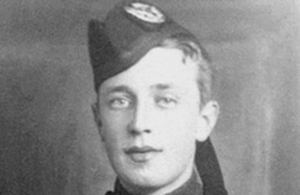WW1 Canadian VC recipient James (Jimmy) Cleland Richardson
The story of Canadian First World War Victoria Cross recipient James (Jimmy) Cleland Richardson.

James (Jimmy) Cleland Richardson [Credit: National Defence Canada]
70 men from Canada received the Victoria Cross, Britain’s highest award for gallantry, during the First World War. As part of the Centenary Commemorations the people of the United Kingdom marked their gratitude to those courageous men by presenting a bronze memorial plaque to their home country engraved with their names. The plaque is now displayed at the British High Commission Ottawa. This archive tells their stories.
Name: James Cleland Richardson
DOB: 25 November 1895
Place of Birth: Bellshill, Scotland
Date of Action: 8 to 9 October 1916
Place of Action: Regina Trench, The Somme
Rank: Private
Regiment: 16th Infantry Battalion, Canadian Expedition Force
James Cleland Richardson (known as Jimmy) was born on 25 November 1895 in Belshill, Scotland but emigrated to Canada as a child. He worked as a driller, and was a cadet in the corps of the Seaforth Highlanders in Vancouver which had a well known piper band. When the First World War broke out, he joined the Canadian Expeditionary Force as a piper in the 16th Infantry Battalion.
Richardson was posthumously awarded his Victoria Cross for most conspicuous bravery and devotion to duty on 8 October 1916 at Regina Trench towards the end of the Battle of the Somme. The 16th Battalion had been tasked with attacking a German position, but Piper Richardson’s company was held up by uncut barbed war and heavy intense gunfire, causing many casualties and sapping morale. Piper Richardson took the initiative and led his comrades, inspiring them by his pipe playing. His citation explains further:
For most conspicuous bravery and devotion to duty when, prior to attack, he obtained permission from his Commanding Officer to play his company ‘over the top.’ As the company approached the objective, it was held up by very strong wire and came under intense fire, which caused heavy casualties and demoralised the formation for the moment. Realising the situation, Piper Richardson strode up and down outside the wire, playing his pipes with the greatest coolness. The effect was instantaneous. Inspired by his splendid example, the company rushed the wire with such fury and determination that the obstacle was overcome and the position captured. Later, after participating in bombing operations, he was detailed to take back a wounded comrade and prisoners. After proceeding about 200 yards Piper Richardson remembered that he had left his pipes behind. Although strongly urged not to do so, he insisted on returning to recover his pipes. He has never been seen since, and death has been presumed accordingly owing to lapse of time.
Private Richardson’s remains were found in 1920, and he was buried in Adanac Military Cemetery in France. His bagpipes were thought to be lost, but were found in 2002 at a school in Scotland. They were officially repatriated to Canada, and they are displayed at the British Columbia Legislature.